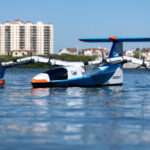In this edition of the CEO Sitdown, Surf/Southern/Mokulele CEO Stan Little sits downs with Billy Thalmeimer, the co-founder and CEO of REGENT, a company developing an all-electric flying watercraft that will deliver safe, reliable, and low-cost travel for coastal communities.
Stan: Billy, I’ve known you for two or three years now, but tell me, where did you grow up?
Billy: I grew up in the Boston area with dreams of going to MIT and being an astronaut. I actually spent a lot of time on the water, too. (I was a competitive sailor in high school.)
Stan: What inspired you to start REGENT?
Billy: In my early years of college at MIT studying aerospace engineering, and after growing up in the New England area, I always sort of had common passions for both aviation and maritime. I wanted those passions to come together.
Stan: Your passions did come together! About REGENT’s flagship vessel, the Viceroy seaglider…what’s always struck me is that wing-in-ground-effect (WIG) flying is not new technology. It’s really the electrification piece and the sizing of the seaglider that’s so new and transformative…
Billy: For sure! It started when I and my co-founder Mike, who’s our CTO, were working in electric aviation, and as you well know, there’s so much going on in that space right now. The problem with the new aircraft being designed is that it takes a billion dollars and a decade to certify when you’re presenting new propulsion systems, new construction methods, and new piloting types. Then, once all that money is spent and the aircraft are certified, they have limited range. We knew we wanted to do New York to Boston, San Francisco to Los Angeles, and after discovering a love of Hawai‘i, we wanted to connect the islands. These routes cannot be done in an all-electric aircraft with today’s battery technology. So, we said, “How do we take the simplicity, the extremely low cost, and the zero emissions of an all-electric solution and apply it in a way where we can double the range over any of these vehicles today?” The solution was the seaglider. We found this interesting because it solves two problems on the aviation side. One, they’re regulated as sea vessels, and two, operationally, they have much longer ranges due to aerodynamically flying on that cushion of air. Electrifying a WIG (Wing-in-Ground Effect) was the solution. Then, we went further with the solution of adding hydrofoils to the WIG design. That is really the key differentiation that unlocked everything. We wanted to operate reliably and comfortably, not just for a commercial mission, but one where you don’t spill your coffee–that’s where that hydrofoil design came in.
Stan: Can you explain to a non-MIT grad how this really works?
Billy: There are three modes of operation. Floating mode is pretty simple, it’s sitting on its hull like a boat, and you board it like a boat. There’s no TSA, you just walk right on. The next mode is the foiling mode. That’s when the hull rises on its hydrofoil like underwater wings (similar to high performance yachting today). Then, the final mode is flying. Obviously, we’re going long distances, and we want to go fast. The seaglider is the first vehicle that’s been able to take-off directly from those hydrofoils. We fly on a cushion of air, which is the same thing that you see birds flying on while gliding over the surface of the water. It’s also that same magical feeling that you get on any commercial aircraft when, in that last second or two when you get over the runway, before the wheels touch, that magical feeling of floating. That is the ground-effect. It’s the air under the wings pushing against the surface of the ground. In the case of seagliders, we will fly in that “floating sensation” all the time. So, Float, Foil, Fly.
Stan: That’s interesting because we all know that feeling of floating for those last couple of seconds prior to landing. Will there be turbulence at that level you fly, like you have with turbulence on an airplane?
Billy: The seaglider has a digital flight control system, so it’s always reacting and balancing, resulting in a very smooth ride. The cool thing about flying in the ground-effect is that you always have that last-second floating feeling that typically is the calmest part of a commercial flight. It should be a much more comfortable ride flying in this ground-effect environment.
Stan: As I’m interviewing you, there’s a picture of a flying seaglider in the background. You’ve already flown one of these, right?
Billy: That’s exactly right. It was really the first thing we wanted to do. Our company is founded by engineers. We had this idea of a novel concept to build a WIG craft that can take-off from a hydrofoil, but we needed to prove that it works. That is the hard part of doing what’s never been done before. We said, “We have this concept, let’s go prove it right now,” and that’s what we did. We designed and built the prototype in about a year. This vehicle has been demonstrating all aspects of floating, foiling, and flying for over a year now.
Stan: Billy, this one is a trick question. How many engines does it have?
Billy: (laughing) Zero, since they’re all electric motors! On our quarter-scale prototype, there are eight motors (four per wing). On the full-scale Viceroy we’re building now, which will be the first human-carrying seaglider, we have 12 electric motors (six per wing).
Stan: Where did you first test it?
Billy: We are based in Rhode Island, so right here in The Ocean State.
Stan: Where is the first one with passengers going to fly?
Billy: We couldn’t be happier to be partnered with Southern/Mokulele (and now the overlay of the Surf brand). You could not have picked a better merger partner than Surf Air!
Stan: How did you go about choosing Mokulele and the Southern/Surf family as the launch customer?
Billy: We were working through the “who is the launch customer” decision and what sort of market profile we needed in that launch customer. When we met you, several things were clear. One, you guys were passionate leaders in the sustainable transportation space. Two, the Hawai‘i market is perfect for this (in Hawai‘i, 7 million passengers per year are moving between the islands–all of which are accessible by Seaglider routes). And the third factor is what your brand stands for. This is not a transportation mode only for the ultra-rich. This is about access and accessibility…making transportation easier. We want to democratize transportation between the islands. So, when these synergies lined-up, it was just so clear that our launch partner should be Mokulele.
Stan: We were thrilled to get the news and to be chosen! So last question, when do we get our first one?
Billy: We are targeting mid-decade right now! We do have a very clear timeline around our full- scale prototype that we’re putting on the water summer of next year. We’re going to fly humans on the first full-scale Viceroy seaglider prototype by the end of next year. After that, we’ll spool-up our manufacturing line and get our first ships out to you!
Stan: I want to be on the first one!
Billy: Send me a ticket and I’ll be right there with you!













